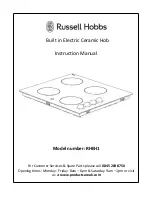
Instructions
35
EN
• While cooking do not place
metal objects, such as cutlery or
dishes on the hob surface as they
may overheat.
• Do not insert pointed metal
objects (cutlery or utensils) into the
slots in the appliance.
• Do not pour water directly on very
hot trays.
• Do not use aerosols in the vicinity
of this appliance whilst it is in use.
• Switch off the appliance after use.
• Do not modify this appliance.
• Do not try to repair the appliance
yourself or without the intervention
of a qualified technician.
• Do not pull the cable to remove
the plug.
• If the power supply cable is
damaged, contact technical
support immediately and they will
replace it.
Risk of damaging the appliance
• Do not use abrasive or corrosive
detergents (e.g. scouring
powders, stain removers and
metallic sponges) on glass parts.
• Use wooden or plastic utensils.
• Do not sit on the appliance.
• Do not use steam jets to clean the
appliance.
• Do not obstruct ventilation
openings and heat dispersal slots.
• Never leave the appliance
unattended during cooking
operations where fats or oils could
overheat and take fire. Be very
careful.
• Never leave objects on the
cooking surface.
• Do not use the appliance to heat
rooms for any reason.
• Do not spray any spray products
near the oven.
• Do not use plastic cookware or
containers for cooking.
• Cooking vessels or griddle plates
should be placed inside the
perimeter of the hob.
• All pans must have smooth, flat
bottoms.
• If any liquid does boil over or spill,
remove the excess from the hob.
• Take care not to spill acid
substances such as lemon juice or
vinegar on the hob.
• Do not put empty pans or frying
pans on switched on cooking
zones.
• Do not use steam jets to clean the
appliance.
• Do not use rough or abrasive
materials or sharp metal scrapers.
Summary of Contents for PV331CN
Page 30: ......




































